Numerical and Experimental Investigation of Flow Characteristics in a Fluid Self-Lubricating Centrifugal Pump with R134a Refrigerant
Abstract
1. Introduction
2. Centrifugal Pump Structure Design and Testing Experiments
2.1. Pump Structure
2.2. Testing Experiment
2.2.1. Test Rig
2.2.2. Test Results
3. Numerical Model
3.1. Numerical Method
3.2. Meshing
4. Results and Discussion
4.1. Single-Phase Flow Characteristics and Internal Flow Characteristics
4.1.1. Internal Flow under Different Flow Rates
4.1.2. Hydrodynamic Bearing Performance with R134a Refrigerant
4.2. Cavitation Characteristics
4.2.1. The Effect of Inducer
4.2.2. Internal Flow Characteristics under Different Cavitation Numbers
4.2.3. Thermal Effect
5. Conclusions
- The numerical model of the centrifugal pump, which utilizes R134a refrigerant and incorporates a self-lubricating mechanism, demonstrates excellent predictive capability for hydraulic performance. By employing a modified Sauer-Schnerr cavitation numerical model, the cavitating performance was accurately predicted. The head coefficient value at design conditions was 0.9981, with a calculation error of 2.6%. The numerical calculations yielded a critical cavitation number of 0.546, which closely matched the experimental value of 0.551, and a breakdown number of 0.347, compared to the experimental value of 0.412.
- With the cavitation number decreases, a significant change occurs to the pump head, and cavitation clouds originate from the leading edge of the inducer and develop downstream along the suction side of the inducer blades. When the cavitation number falls below the critical value, cavitation clouds begin to emerge at the trailing edge of the inducer. The bubbles gradually expand within the flow passage, leading to a sudden decrease in the impeller blades’ pressure capacity and a rapid drop of the pump head.
- The installation of an inducer at the impeller’s upstream reduces effectively the pump’s critical and breakdown numbers. After installing the inducer, the critical cavitation number decreases from 0.783 to 0.566, and the breakdown number decreases from 0.718 to 0.372. Different from the pump with an inducer, the pump head curve drops more steeply after reaching the critical cavitation number, indicating that the cavitation condition in the flow passages deteriorates rapidly with decreasing inlet pressure.
- With the occurrence of cavitation, the thermal effect of refrigerant impacts the cavitating process of the pump. In the case of the isothermal model, the bubble fraction and temperature drop were overestimated, reaching 100% and 30 K, respectively. However, in the non-isothermal model, these values were less than 50% and 2 K, respectively. The thermal effect of the refrigerant suppresses the development of cavitation clouds due to the temperature increase.
Author Contributions
Funding
Institutional Review Board Statement
Informed Consent Statement
Data Availability Statement
Conflicts of Interest
References
- Marcinichen, J.B.; Olivier, J.A.; Thome, J.R. On-Chip Two-Phase Cooling of Datacenters: Cooling System and Energy Recovery Evaluation. Appl. Therm. Eng. 2012, 41, 36–51. [Google Scholar] [CrossRef]
- Zhou, F.; Wei, C.; Ma, G. Development and Analysis of a Pump-Driven Loop Heat Pipe Unit for Cooling a Small Data Center. Appl. Therm. Eng. 2017, 124, 1169–1175. [Google Scholar] [CrossRef]
- Chen, X.; Ding, T.; Cao, H.; Ding, H.; Li, Z. Flow Boiling Heat Transfer Mechanisms and Flow Characteristics of Pump-Driven Two-Phase Flow Systems Used in Data Center Cooling. Appl. Therm. Eng. 2023, 220, 119642. [Google Scholar] [CrossRef]
- Nakano, S.; Kishibe, T.; Inoue, T.; Shiraiwa, H. An Advanced Microturbine System with Water-Lubricated Bearings. Int. J. Rotating Mach. 2009, 2009, 718107. [Google Scholar] [CrossRef]
- Yuan, X.; Zhang, G.; Zhao, W.; Li, Z.; Yang, S. Theoretical and Experimental Approach for the Characteristics of Water-Lubricated, High-Speed Double Spiral-Groove Face Seals. In International Joint Tribology Conference; American Society of Mechanical Engineers Digital Collection: New York, NY, USA, 2008; pp. 399–407. [Google Scholar]
- Yuan, X.; Zhang, G.; Li, B.; Miao, X. Theoretical and Experimental Results of Water-Lubricated, High-Speed, Short-Capillary-Compensated Hybrid Journal Bearings. In International Joint Tribology Conference; American Society of Mechanical Engineers Digital Collection: New York, NY, USA, 2008; pp. 391–398. [Google Scholar]
- Kumar, V.; Sharma, S.C.; Jain, S.C. On the Restrictor Design Parameter of Hybrid Journal Bearing for Optimum Rotordynamic Coefficients. Tribol. Int. 2006, 39, 356–368. [Google Scholar] [CrossRef]
- Prehn, R.; Haupert, F.; Friedrich, K. Sliding Wear Performance of Polymer Composites under Abrasive and Water Lubricated Conditions for Pump Applications. Wear 2005, 259, 693–696. [Google Scholar] [CrossRef]
- Soyama, H.; Li, S.R.; Tonosaki, M.; Uranishi, K.; Kato, H.; Oba, R. High-Speed Observations of Severe Cavitation Erosion in a High-Specific-Speed Centrifugal Pump. Trans. Jpn. Soc. Mech. Eng. Part B 1995, 61, 3945–3951. [Google Scholar] [CrossRef]
- Arndt, R.E.A. Cavitation in Fluid Machinery and Hydraulic Structures. Annu. Rev. Fluid Mech. 1981, 13, 273–326. [Google Scholar] [CrossRef]
- Horiguchi, H.; Watanabe, S.; Tsujimoto, Y. A Linear Stability Analysis of Cavitation in a Finite Blade Count Impeller. J. Fluids Eng. 2000, 122, 798–805. [Google Scholar] [CrossRef]
- Xue, R.; Lin, X.; Zhang, B.; Zhou, H.; Lai, T.; Hou, Y. CFD and Energy Loss Model Analysis of High-Speed Centrifugal Pump with Low Specific Speed. Appl. Sci. 2022, 12, 7435. [Google Scholar] [CrossRef]
- Xue, R.; Cai, Y.; Fang, X.; Chen, L.; Zhang, X.; Hou, Y. Optimization Study on a Novel High-Speed Oil-Free Centrifugal Water Pump with Hydrodynamic Bearings. Appl. Sci. 2019, 16, 3050. [Google Scholar] [CrossRef]
- Bai, L.; Zhou, L.; Han, C.; Zhu, Y.; Shi, W. Numerical Study of Pressure Fluctuation and Unsteady Flow in a Centrifugal Pump. Processes 2019, 7, 354. [Google Scholar] [CrossRef]
- Lin, X.; Zhang, B.; Zhang, M.; Zhao, Y.; Lai, T.; Chen, L.; Xue, R. Influence of Internal Flow on the Performance of High-Speed Centrifugal Pumps with a Fully Sealed Structure. Appl. Sci. 2022, 12, 5263. [Google Scholar] [CrossRef]
- Fang, X.; Hou, Y.; Cai, Y.; Chen, L.; Lai, T.; Chen, S. Study on a High-Speed Oil-Free Pump with Fluid Hydrodynamic Lubrication. Adv. Mech. Eng. 2020, 12, 1687814020945463. [Google Scholar] [CrossRef]
- Kobayashi, K.; Chiba, Y. Computational Fluid Dynamics of Cavitating Flow in Mixed Flow Pump with Closed Type Impeller. Int. J. Fluid Mach. Syst. 2010, 3, 113–121. [Google Scholar] [CrossRef]
- Xu, Y.; Tan, L.; Liu, Y.; Cao, S. Pressure Fluctuation and Flow Pattern of a Mixed-Flow Pump with Different Blade Tip Clearances under Cavitation Condition. Adv. Mech. Eng. 2017, 9, 1687814017696227. [Google Scholar] [CrossRef]
- Medvitz, R.B.; Kunz, R.F.; Boger, D.A.; Lindau, J.W.; Yocum, A.M.; Pauley, L.L. Performance Analysis of Cavitating Flow in Centrifugal Pumps Using Multiphase CFD. J. Fluids Eng. 2002, 124, 377–383. [Google Scholar] [CrossRef]
- Fukaya, M.; Tamura, Y.; Matsumoto, Y. Prediction of Cavitation Intensity and Erosion Area in Centrifugal Pump by Using Cavitating Flow Simulation with Bubble Flow Model. J. Fluid Sci. Technol. 2010, 5, 305–316. [Google Scholar] [CrossRef]
- Wang, Y.; Liu, H.; Liu, D.; Yuan, S.; Wang, J.; Jiang, L. Application of the Two-Phase Three-Component Computational Model to Predict Cavitating Flow in a Centrifugal Pump and Its Validation. Comput. Fluids 2016, 131, 142–150. [Google Scholar] [CrossRef]
- Stopa, M.M.; Cardoso Filho, B.J.; Martinez, C.B. Incipient Detection of Cavitation Phenomenon in Centrifugal Pumps. IEEE Trans. Ind. Applicat. 2014, 50, 120–126. [Google Scholar] [CrossRef]
- Cui, B.; Han, X.; An, Y. Numerical Simulation of Unsteady Cavitation Flow in a Low-Specific-Speed Centrifugal Pump with an Inducer. JMSE 2022, 10, 630. [Google Scholar] [CrossRef]
- Franc, J.-P.; Rebattet, C.; Coulon, A. An Experimental Investigation of Thermal Effects in a Cavitating Inducer. J. Fluids Eng. 2004, 126, 716–723. [Google Scholar] [CrossRef]
- Franc, J.-P.; Janson, E.; Morel, P.; Rebattet, C.; Riondet, M. Visualizations of Leading Edge Cavitation in an Inducer at Different Temperatures. In Proceedings of the 4th International Symposium on Cavitation, Pasadena, CA, USA, 20–23 June 2001. [Google Scholar]
- Cervone, A.; Testa, R.; Bramanti, C.; Rapposelli, E.; d’Agostino, L. Thermal Effects on Cavitation Instabilities in Helical Inducers. J. Propuls. Power 2005, 21, 893–899. [Google Scholar] [CrossRef]
- Rapposelli, E. A barotropic cavitation model with thermodynamic effects. In Proceedings of the 5th International Symposium on Cavitation CAV2003, Osaka, Japan, 1–4 November 2003. [Google Scholar]
- Palgrave, R.; Cooper, P. Visual Studies of Cavitation in Pumping Machinery. In Proceedings of the 3rd International Pump Symposium, College Station, TX, USA, 1 May 1986. [Google Scholar] [CrossRef]
- Lu, J.; Yuan, S.; Parameswaran, S.; Yuan, J.; Ren, X.; Si, Q. Investigation on the Vibration and Flow Instabilities Induced by Cavitation in a Centrifugal Pump. Adv. Mech. Eng. 2017, 9, 168781401769622. [Google Scholar] [CrossRef]
- Gao, B.; Guo, P.; Zhang, N.; Li, Z.; Yang, M. Experimental Investigation on Cavitating Flow Induced Vibration Characteristics of a Low Specific Speed Centrifugal Pump. Shock Vib. 2017, 2017, 6568930. [Google Scholar] [CrossRef]
- Zhang, N.; Gao, B.; Li, Z.; Jiang, Q. Cavitating Flow-Induced Unsteady Pressure Pulsations in a Low Specific Speed Centrifugal Pump. R. Soc. Open Sci. 2018, 5, 180408. [Google Scholar] [CrossRef]
- Friedrichs, J.; Kosyna, G. Rotating Cavitation in a Centrifugal Pump Impeller of Low Specific Speed. J. Fluids Eng. 2002, 124, 356–362. [Google Scholar] [CrossRef]
- Duplaa, S.; Coutier-Delgosha, O.; Dazin, A.; Roussette, O.; Bois, G.; Caignaert, G. Experimental Study of a Cavitating Centrifugal Pump during Fast Startups. J. Fluids Eng. 2010, 132, 021301. [Google Scholar] [CrossRef]
- Shervani-Tabar, N.; Sedaaghi, R.; Mohajerin, R.; Shervani-Tabar, M.T.; Bourisli, R.I. Experimental and Computational Investigation on the Cavitation Phenomenon in a Centrifugal Pump. In Proceedings of the 8th International Symposium on Cavitation, Singapore, 13–16 August 2012; Research Publishing Services: Singapore, 2012; pp. 489–497. [Google Scholar]
- Zuo, Z.; Li, S.; Liu, S.; Li, S.; Chen, H. An Attribution of Cavitation Resonance: Volumetric Oscillations of Cloud. J. Hydrodyn. Ser. B 2009, 21, 152–158. [Google Scholar] [CrossRef]
- Foeth, E.J.; Van Doorne, C.W.H.; Van Terwisga, T.; Wieneke, B. Time Resolved PIV and Flow Visualization of 3D Sheet Cavitation. Exp. Fluids 2006, 40, 503–513. [Google Scholar] [CrossRef]
- Atif, A.; Benmansour, S.; Bois, G.; Dupont, P. Numerical and Experimental Comparison of the Vaned Diffuser Interaction inside the Impeller Velocity Field of a Centrifugal Pump. Sci. China Technol. Sci. 2011, 54, 286–294. [Google Scholar] [CrossRef]
- Jia, X.; Zhang, Y.; Lv, H.; Zhu, Z. Study on External Performance and Internal Flow Characteristics in a Centrifugal Pump under Different Degrees of Cavitation. Phys. Fluids 2023, 35, 014104. [Google Scholar] [CrossRef]
- Chatterjee, D.; Arakeri, V.H. Towards the Concept of Hydrodynamic Cavitation Control. J. Fluid Mech. 1997, 332, 377–394. [Google Scholar] [CrossRef]
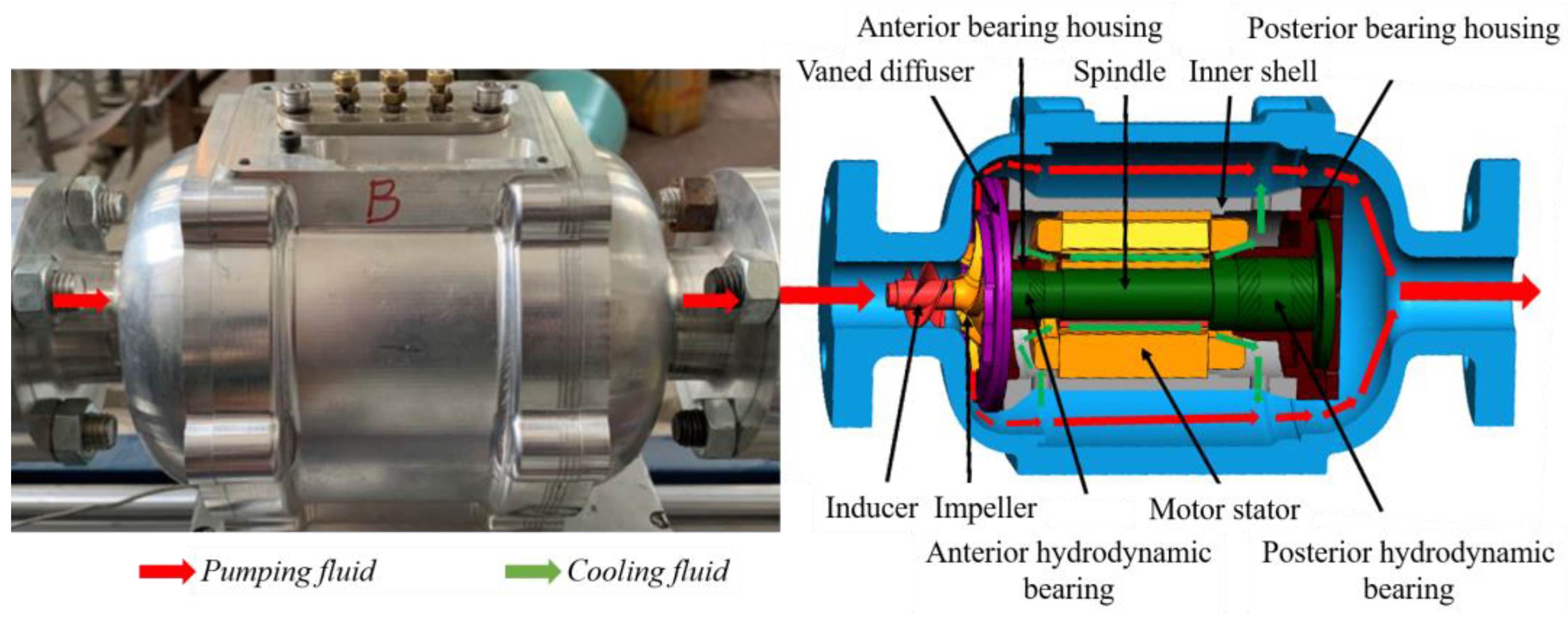
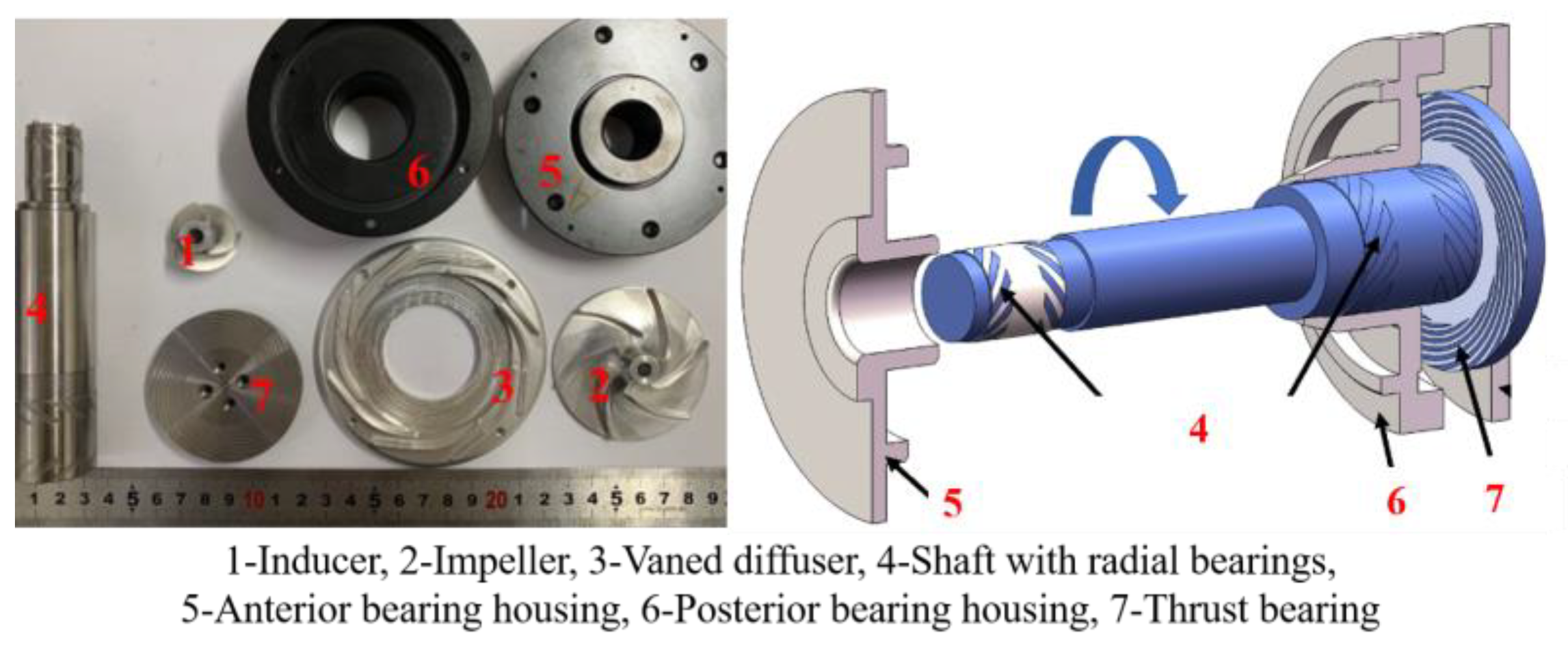

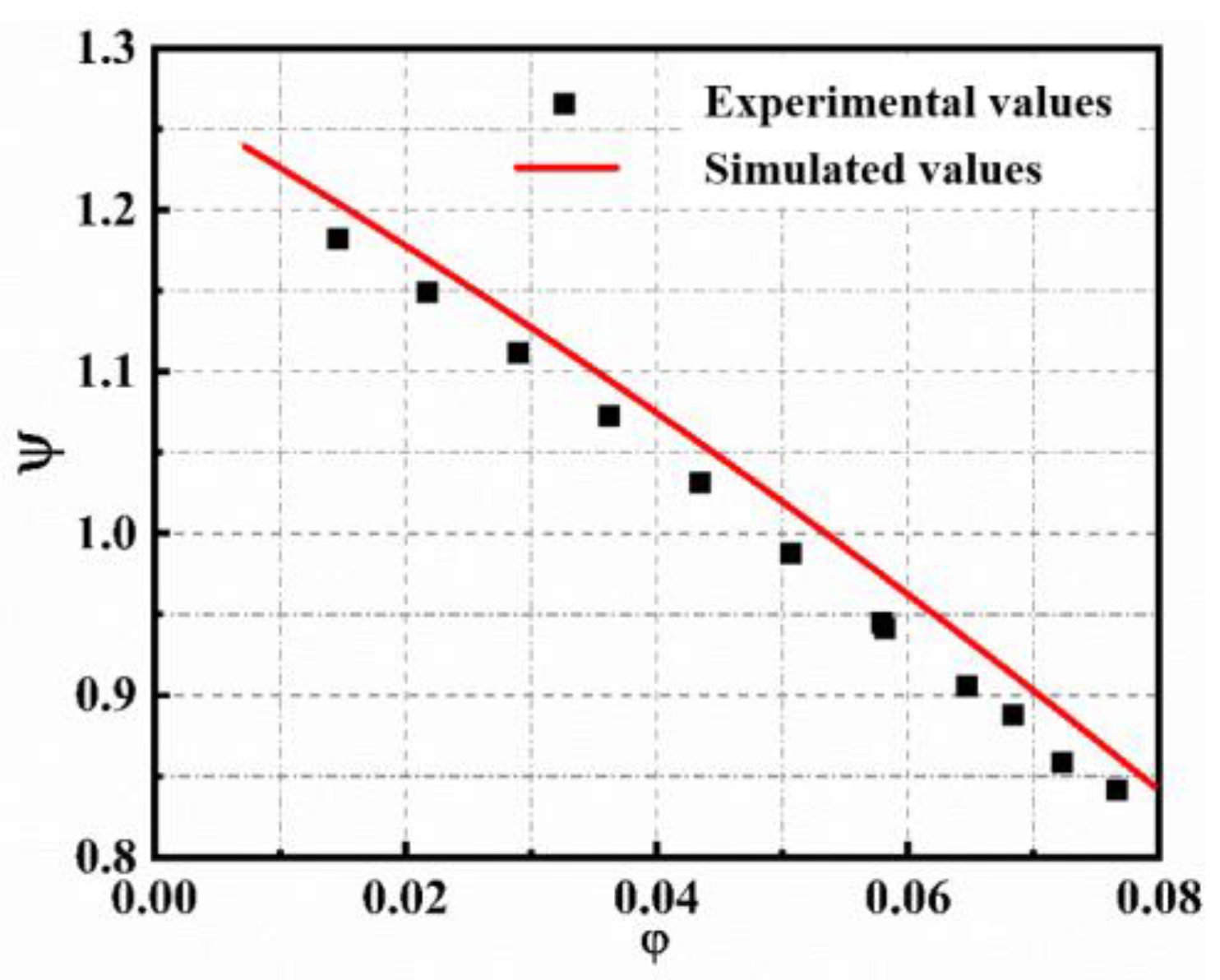

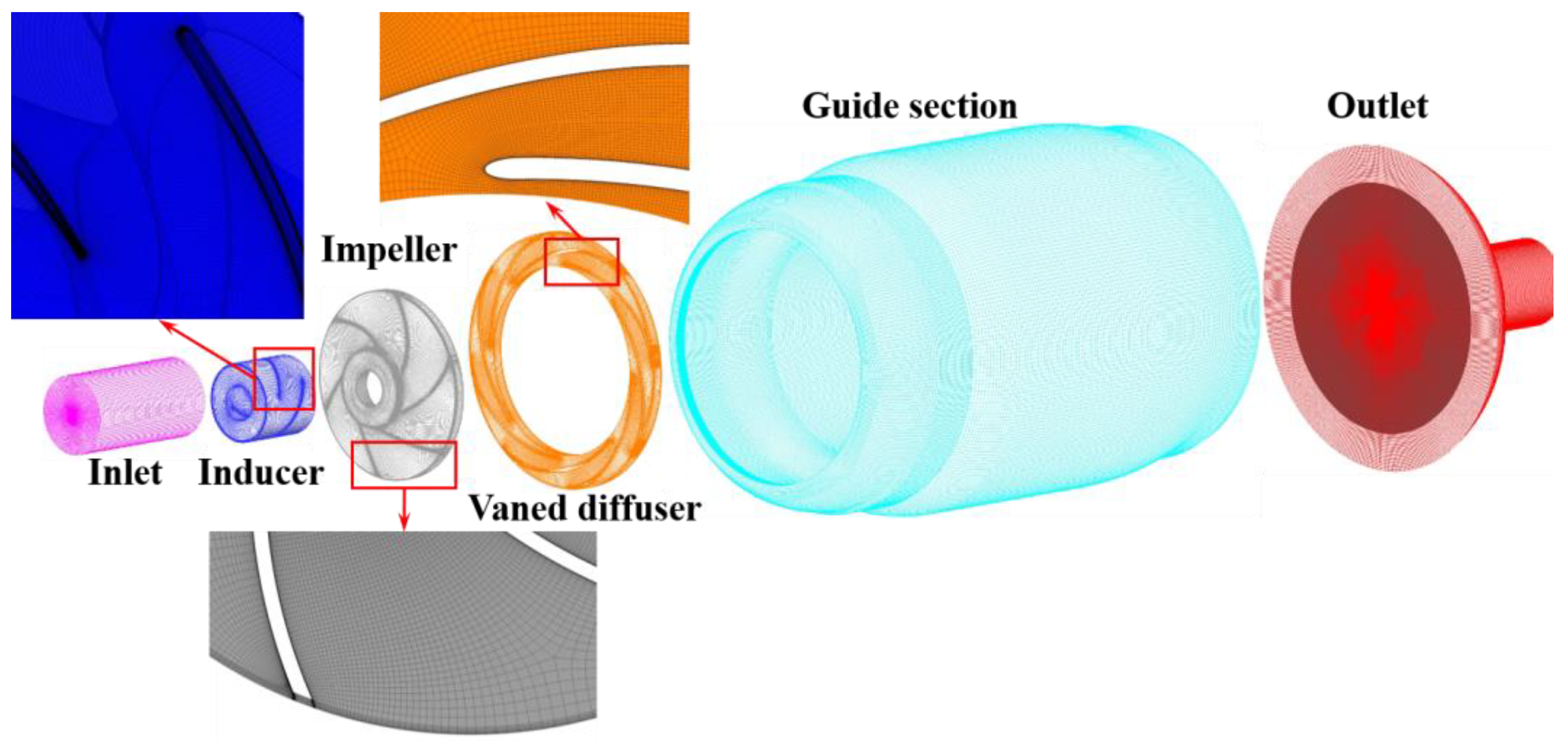

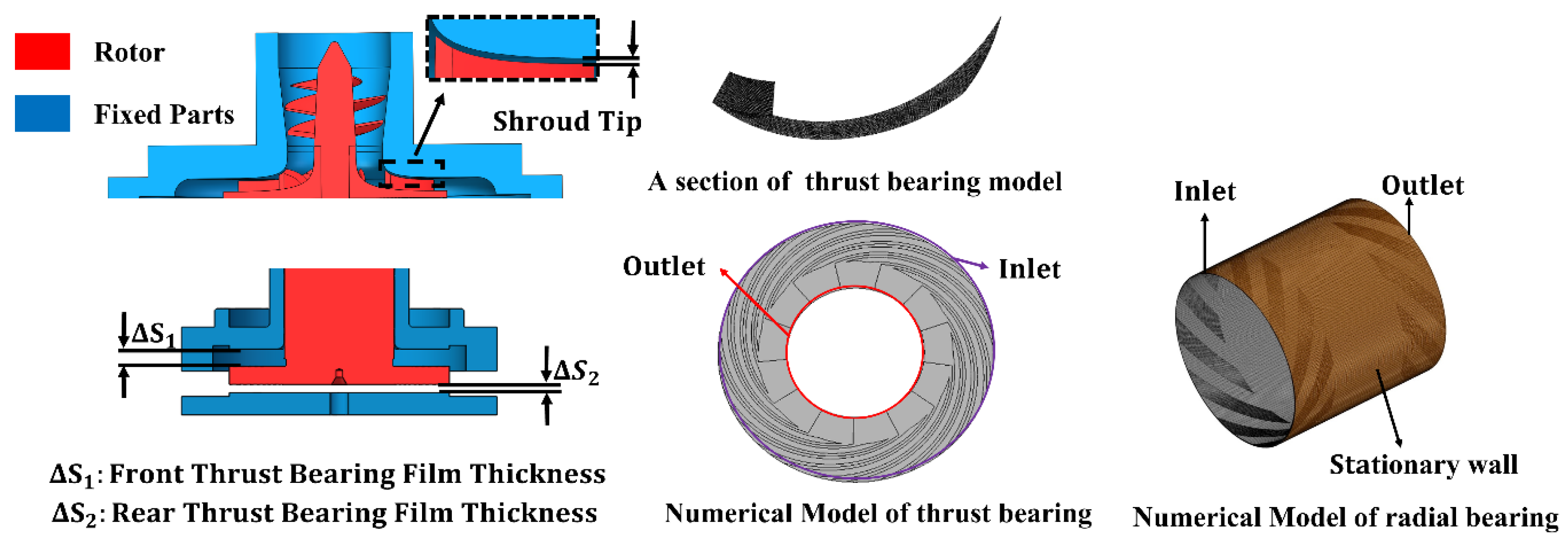
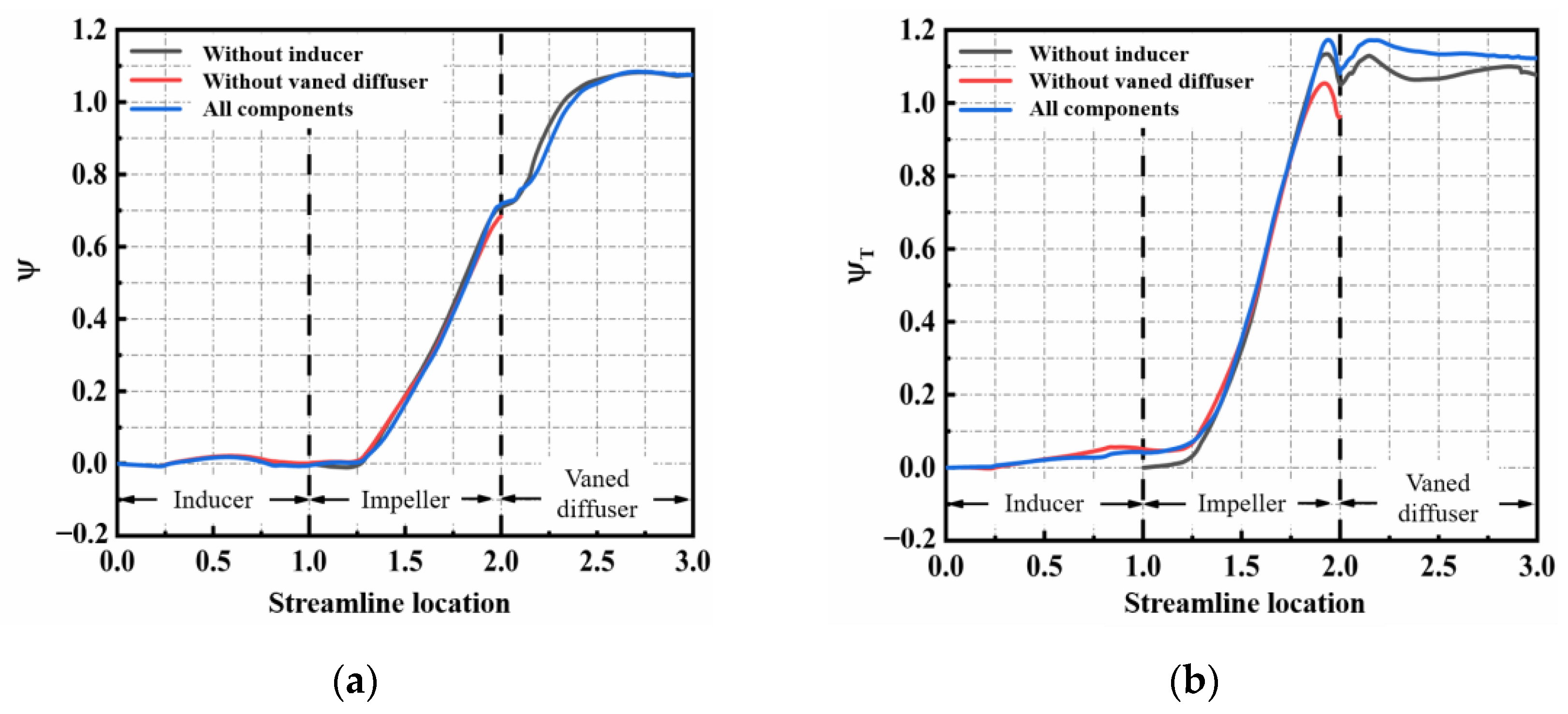

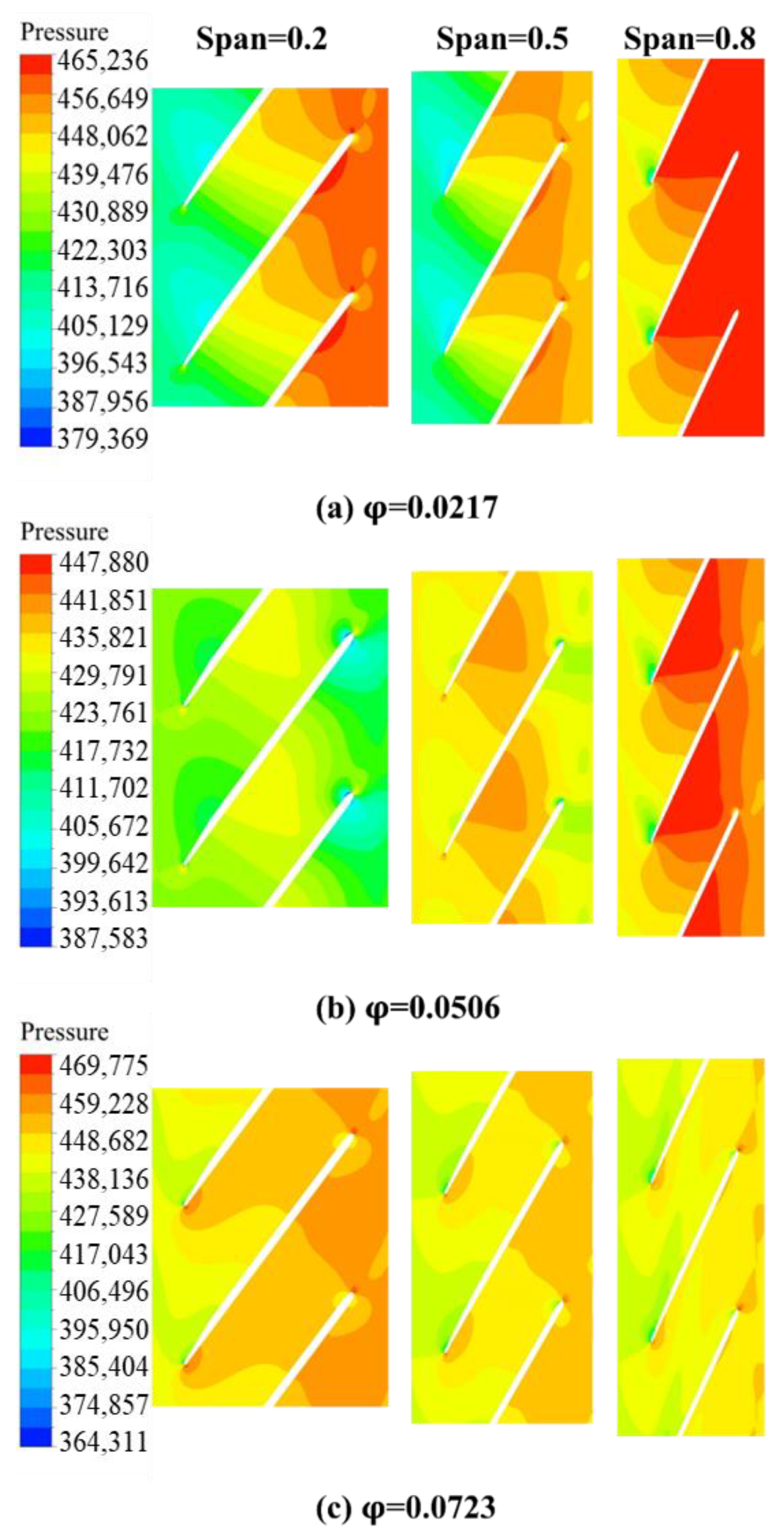

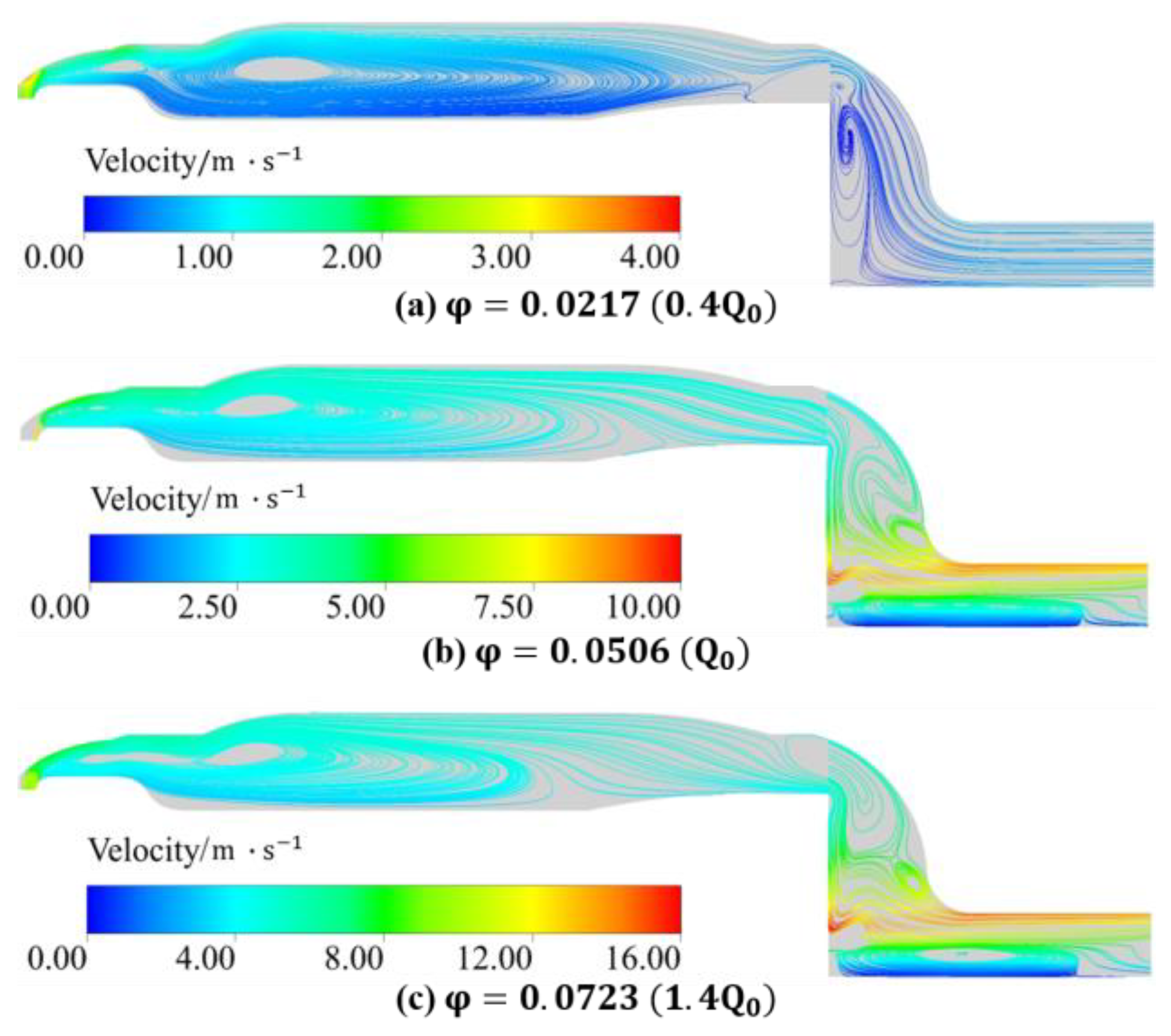

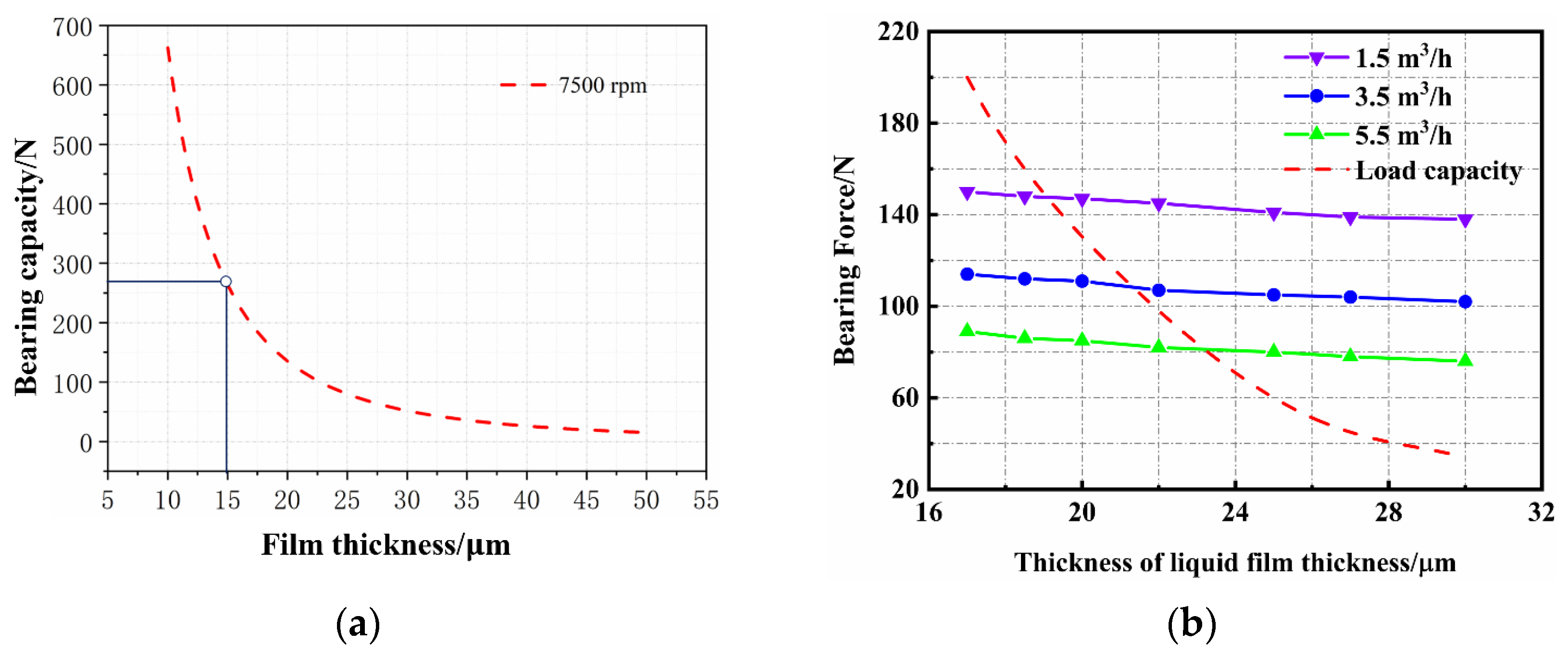


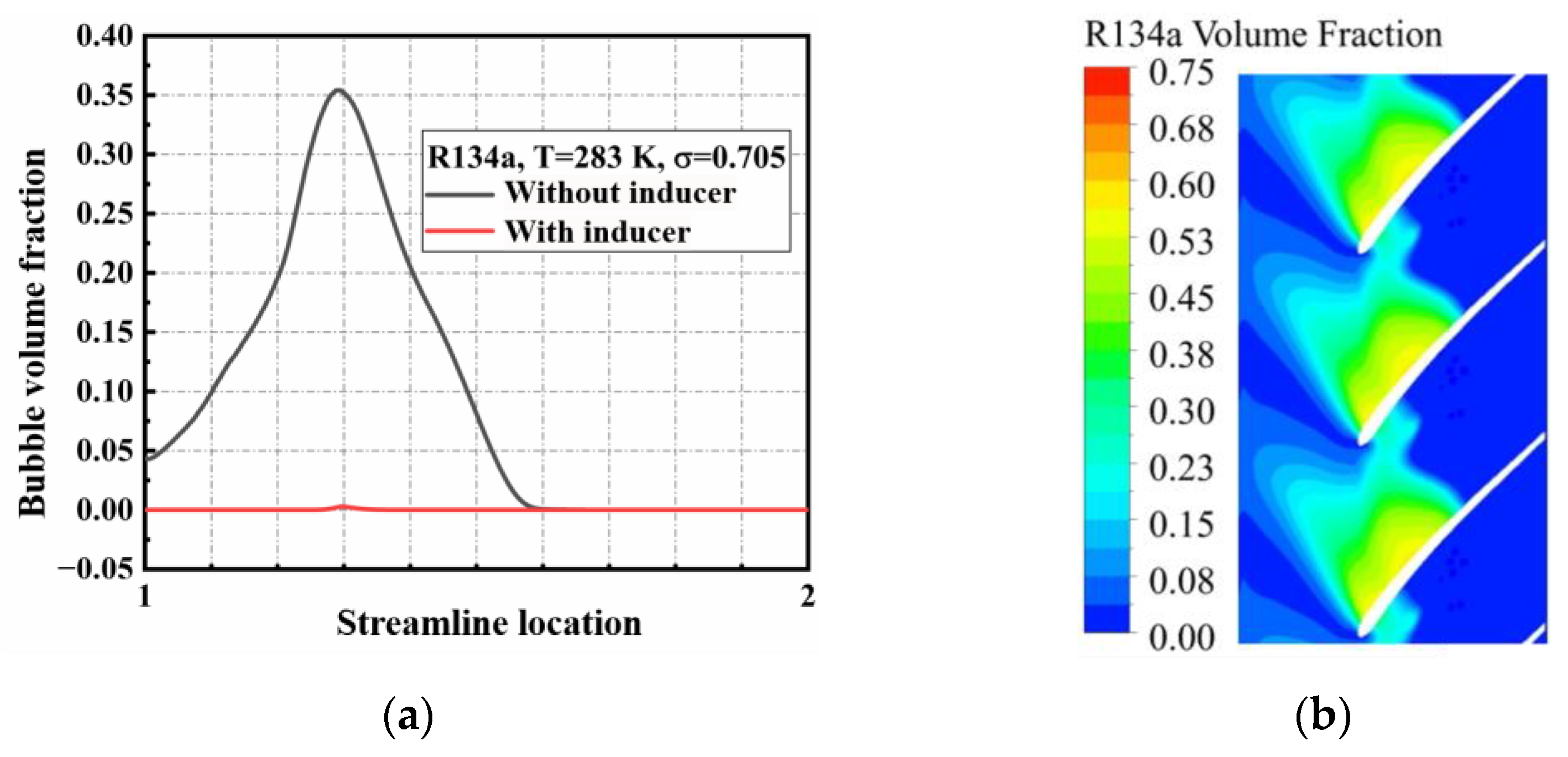
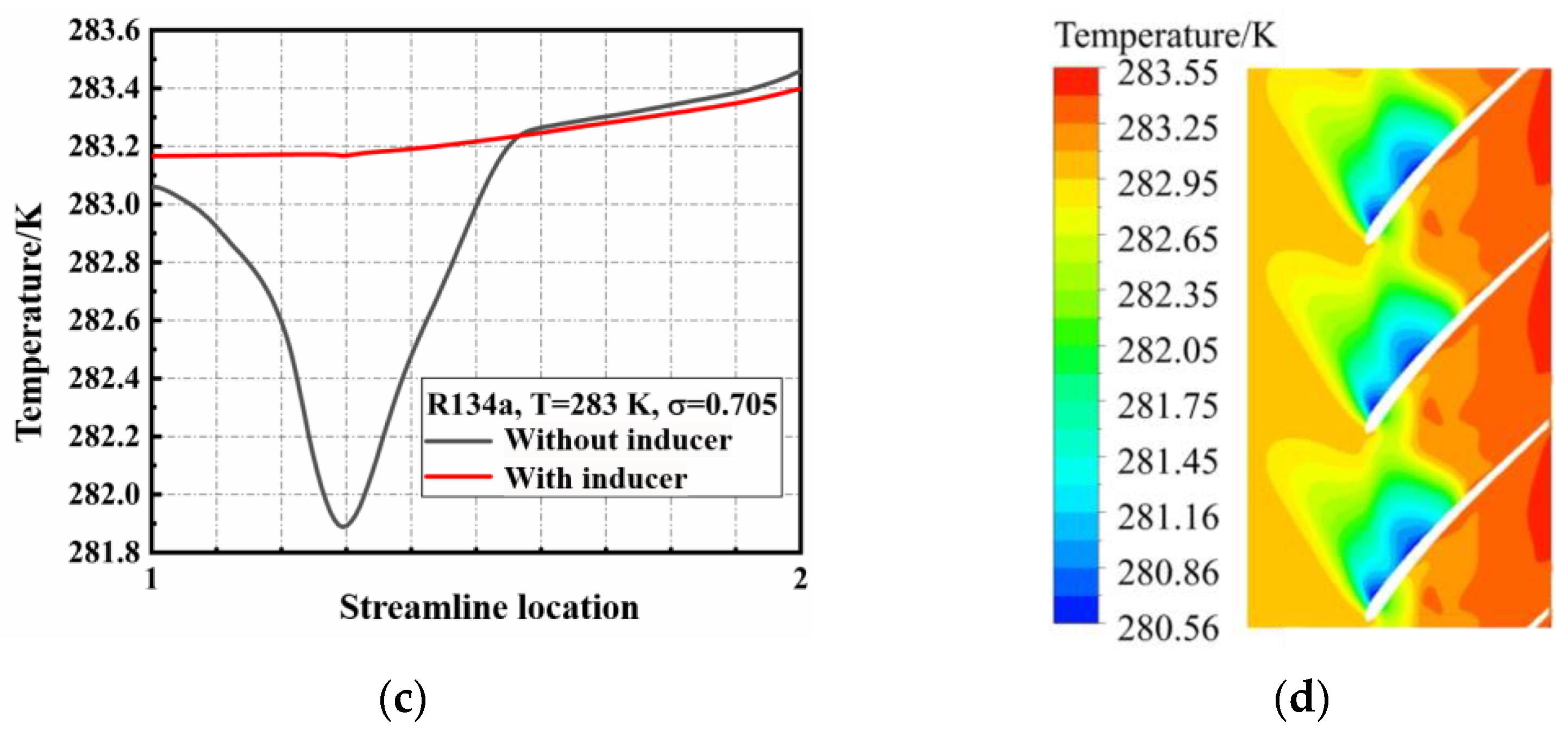
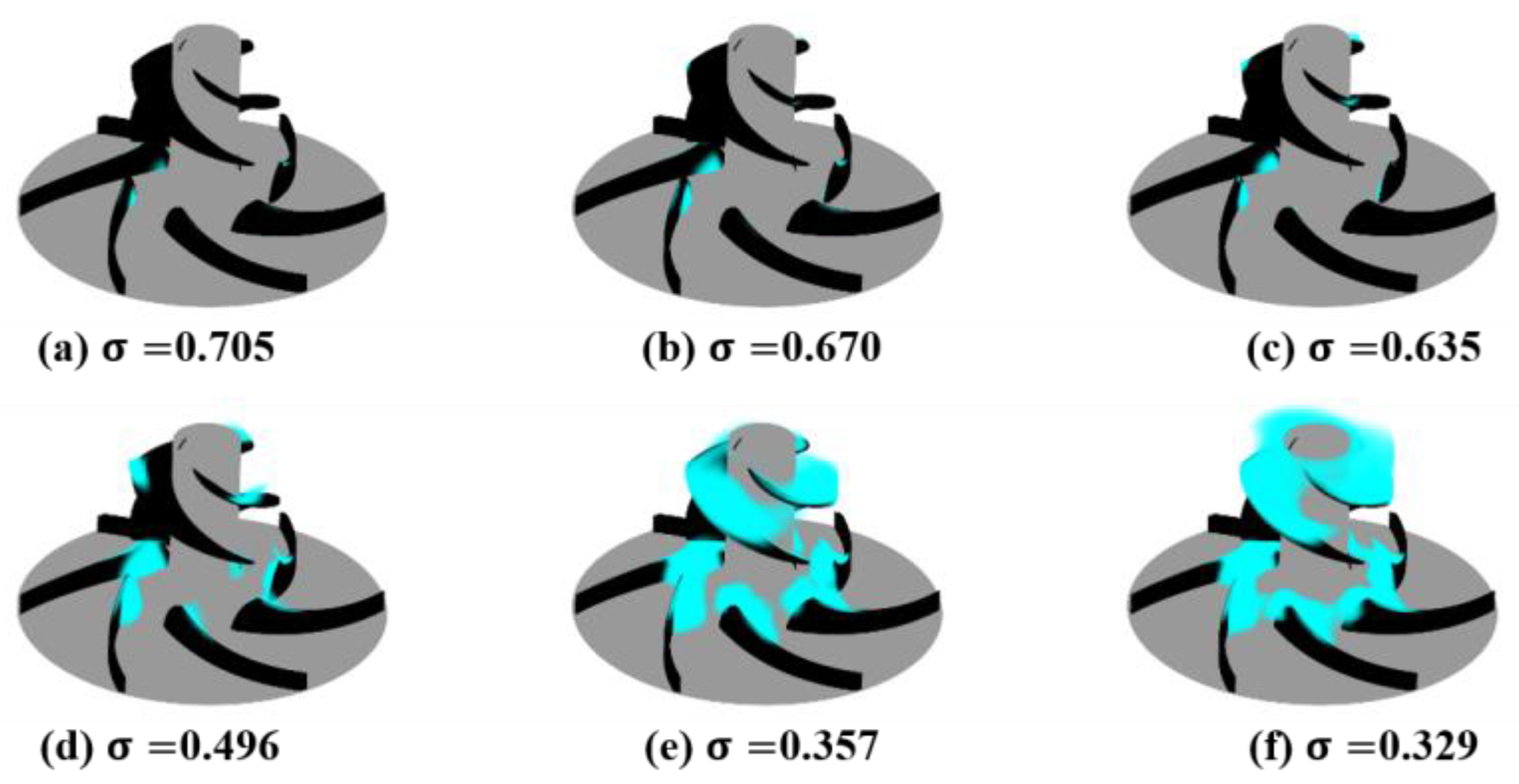

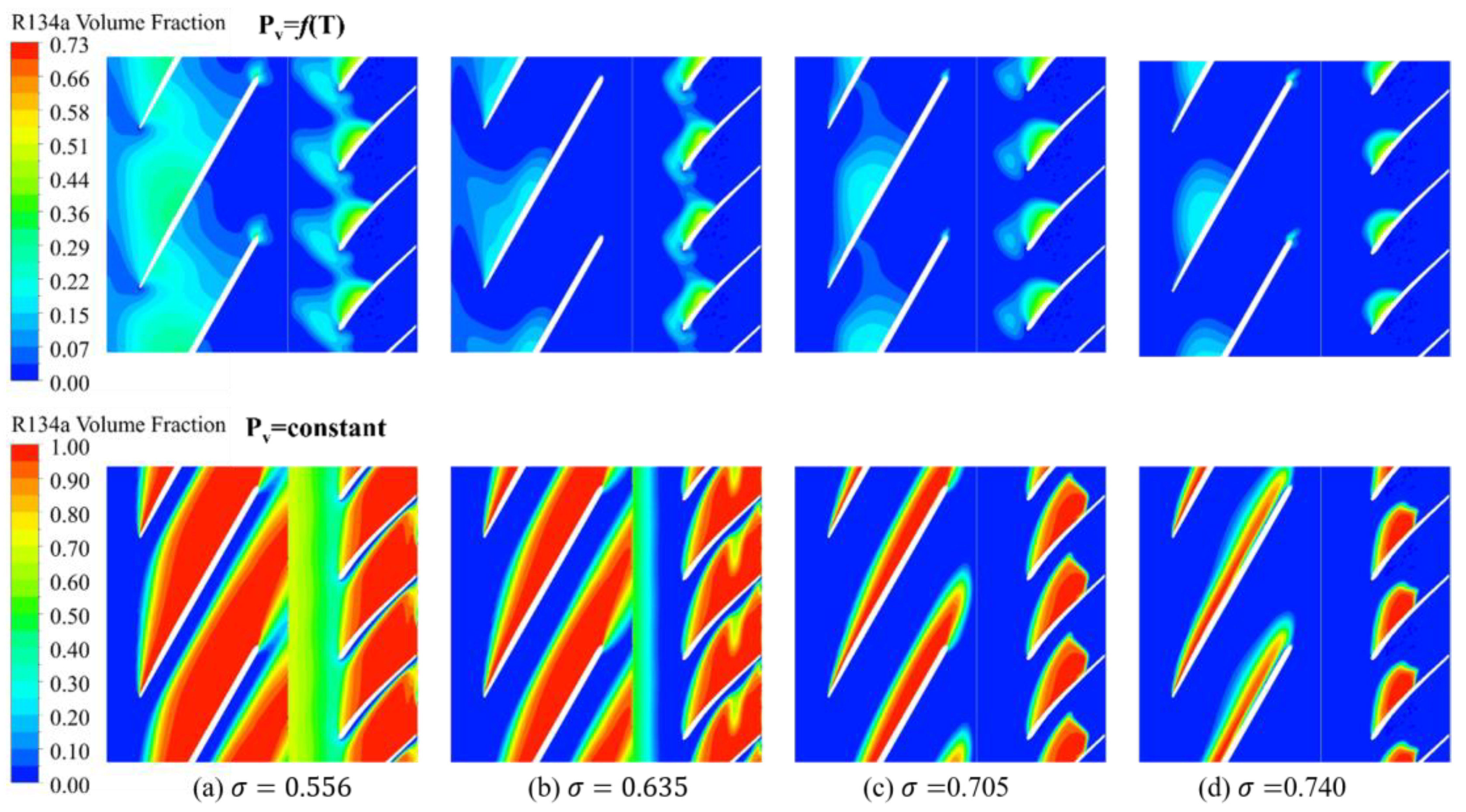
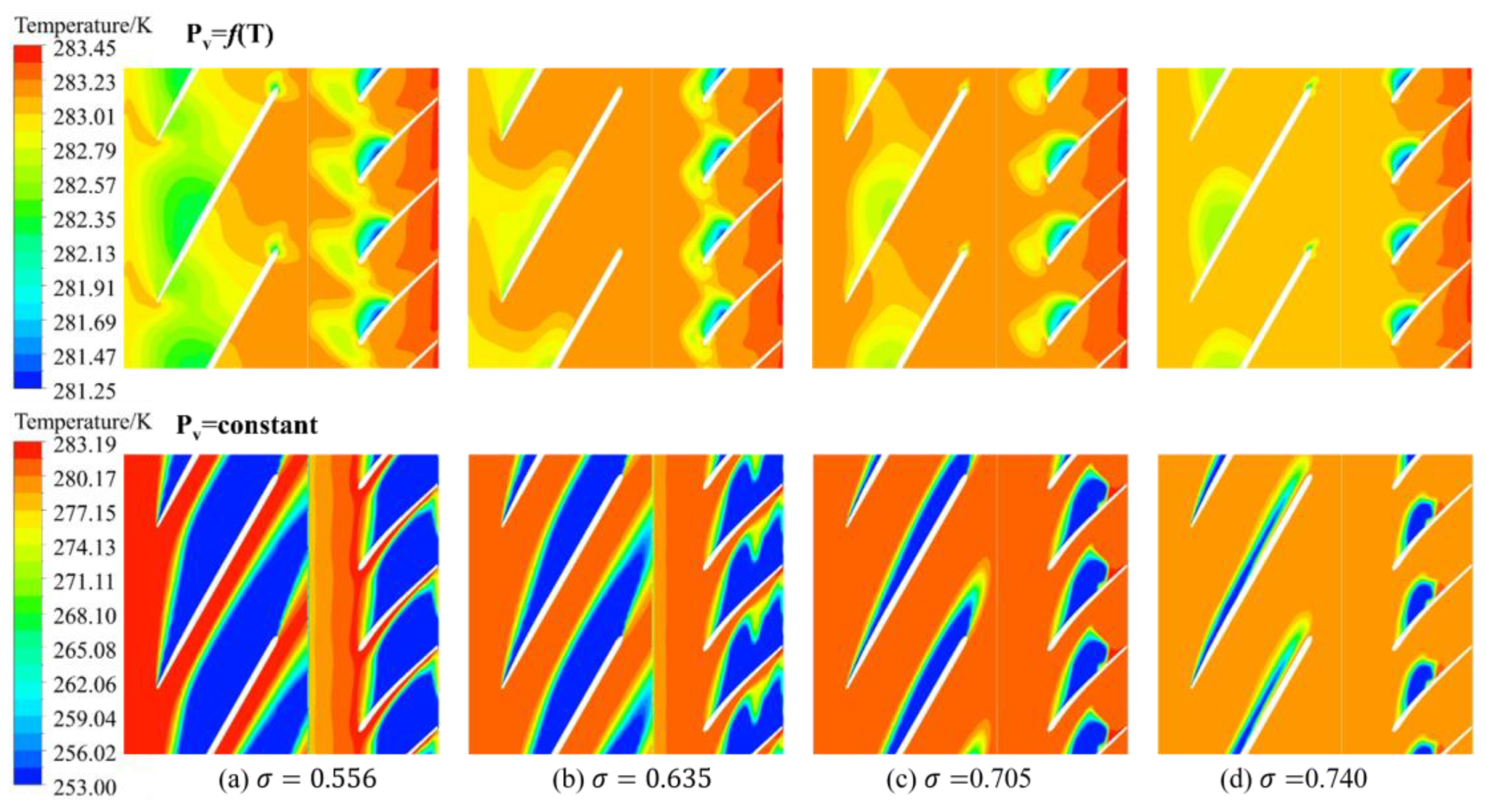

| Parameter | Symbol | Value | |
|---|---|---|---|
| Inducer | Number of blades | Zla, ind | 3 |
| Inlet diameter | di1 | 27.2 mm | |
| Inlet blade angle | 43° | ||
| Wrap angle | Δφ | 160.3° | |
| Outlet diameter | di2 | 27.2 mm | |
| Impeller | Number of blades | Zla, imp | 6 |
| Inlet diameter | d3 | 27.2 mm | |
| Blade outlet width | b3 | 3.8 mm | |
| Outlet blade angle | 14.8° | ||
| Outlet diameter | d4 | 64.0 mm | |
| Vaned diffuser | Number of blades | Z3 | 8 |
| Inlet diameter | d5 | 65.0 mm | |
| Outlet angle | 5.8° | ||
| Outlet diameter | d6 | 82.0 mm | |
| Computational Domain | Rotating Speed/rpm | Temperature/K | Cavitation Number | |
|---|---|---|---|---|
| All components | 3000, 4500, 6000, and 7500 | 1~5.5 | 278, 283, and 288 | 0.3~1.0 |
| Without inducer | ||||
| Without vaned diffuser |
| Working Fluid | Water | R134a Refrigerant |
|---|---|---|
| Temperature | 288 K | 288 K |
| Saturation pressure | 1.69 kPa | 486.03 kPa |
| Liquid-gas density ratio | 78519.3 | 52.6 |
| Heat of vapor | 2465.7 kJ/kg | 186.7 kJ/kg |
| Liquid thermal conductivity | 588.45 mW/(m∙K) | 85.51 mW/(m∙K) |
Disclaimer/Publisher’s Note: The statements, opinions and data contained in all publications are solely those of the individual author(s) and contributor(s) and not of MDPI and/or the editor(s). MDPI and/or the editor(s) disclaim responsibility for any injury to people or property resulting from any ideas, methods, instructions or products referred to in the content. |
© 2023 by the authors. Licensee MDPI, Basel, Switzerland. This article is an open access article distributed under the terms and conditions of the Creative Commons Attribution (CC BY) license (https://creativecommons.org/licenses/by/4.0/).
Share and Cite
Fang, X.; Zhang, B.; Lin, X.; Zhou, H.; Chen, S.; Hou, Y.; Xue, R.; Zhang, Z. Numerical and Experimental Investigation of Flow Characteristics in a Fluid Self-Lubricating Centrifugal Pump with R134a Refrigerant. Appl. Sci. 2023, 13, 8062. https://doi.org/10.3390/app13148062
Fang X, Zhang B, Lin X, Zhou H, Chen S, Hou Y, Xue R, Zhang Z. Numerical and Experimental Investigation of Flow Characteristics in a Fluid Self-Lubricating Centrifugal Pump with R134a Refrigerant. Applied Sciences. 2023; 13(14):8062. https://doi.org/10.3390/app13148062
Chicago/Turabian StyleFang, Xufeng, Beile Zhang, Xinyi Lin, Hong Zhou, Shuangtao Chen, Yu Hou, Rong Xue, and Ze Zhang. 2023. "Numerical and Experimental Investigation of Flow Characteristics in a Fluid Self-Lubricating Centrifugal Pump with R134a Refrigerant" Applied Sciences 13, no. 14: 8062. https://doi.org/10.3390/app13148062
APA StyleFang, X., Zhang, B., Lin, X., Zhou, H., Chen, S., Hou, Y., Xue, R., & Zhang, Z. (2023). Numerical and Experimental Investigation of Flow Characteristics in a Fluid Self-Lubricating Centrifugal Pump with R134a Refrigerant. Applied Sciences, 13(14), 8062. https://doi.org/10.3390/app13148062






